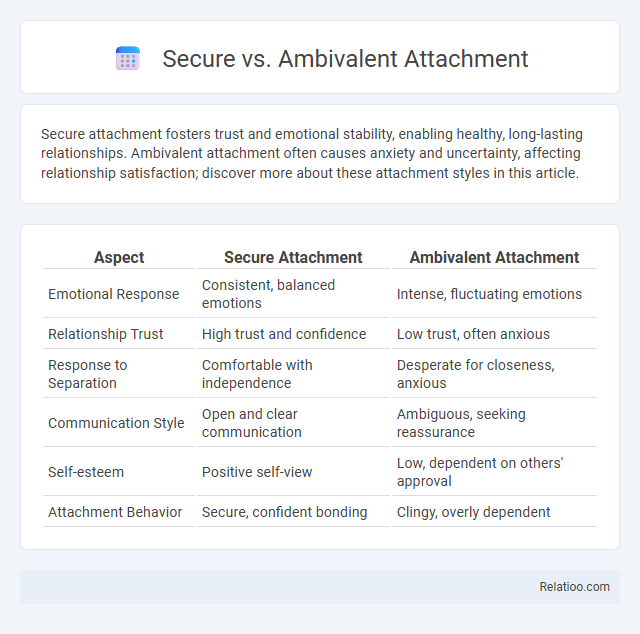Secure attachment fosters trust and emotional stability, enabling healthy, long-lasting relationships. Ambivalent attachment often causes anxiety and uncertainty, affecting relationship satisfaction; discover more about these attachment styles in this article.
Table of Comparison
| Aspect | Secure Attachment | Ambivalent Attachment |
|---|---|---|
| Emotional Response | Consistent, balanced emotions | Intense, fluctuating emotions |
| Relationship Trust | High trust and confidence | Low trust, often anxious |
| Response to Separation | Comfortable with independence | Desperate for closeness, anxious |
| Communication Style | Open and clear communication | Ambiguous, seeking reassurance |
| Self-esteem | Positive self-view | Low, dependent on others' approval |
| Attachment Behavior | Secure, confident bonding | Clingy, overly dependent |
Understanding Attachment Theory
Understanding attachment theory reveals secure attachment as characterized by trust and effective emotional regulation, promoting healthy relationships and well-being. Ambivalent attachment involves anxiety and uncertainty, leading to clinginess or insecurity in interpersonal interactions. Recognizing your attachment style enhances relational awareness and supports personal growth by improving emotional connections.
Defining Secure Attachment
Secure attachment is characterized by a strong emotional bond where individuals feel confident in their relationships and trust that others will be available and supportive when needed. This attachment style promotes healthy interpersonal connections, emotional regulation, and resilience. In contrast, ambivalent attachment involves anxiety and uncertainty about others' responsiveness, leading to clinginess or dependence, while secureness refers broadly to a sense of safety and stability in attachment but is specifically defined through consistent, reliable caregiving that fosters secure attachment patterns.
Defining Ambivalent Attachment
Ambivalent attachment is characterized by clinginess and anxiety, where individuals experience inconsistent responses from caregivers, leading to uncertainty about the availability and supportiveness of attachment figures. This attachment style contrasts with secure attachment, which involves trust and confidence that caregivers will respond reliably. Ambivalently attached individuals often struggle with emotional regulation and may exhibit intense distress upon separation, reflecting insecurity in relational bonds.
Key Differences Between Secure and Ambivalent Attachment
Secure attachment is characterized by consistent responsiveness from caregivers, fostering trust and confidence in relationships, while ambivalent attachment arises from inconsistent caregiver availability, leading to anxiety and uncertainty. Your emotional regulation and ability to seek comfort effectively are stronger with secure attachment, whereas ambivalent attachment often results in heightened clinginess and difficulty managing distress. The key difference lies in the predictability of caregiver support, which influences whether your attachment style promotes stability or emotional ambivalence in social connections.
Origins and Development of Attachment Styles
Attachment styles originate from early interactions with primary caregivers, shaping your emotional bonds and relationship behaviors throughout life. Secure attachment develops when caregivers consistently respond to needs, fostering trust and confidence. Ambivalent attachment arises from inconsistent caregiving, leading to anxiety and uncertainty, while a sense of secureness reflects internalized stability and emotional safety from these formative experiences.
Impact on Emotional Regulation
Secure attachment fosters effective emotional regulation by promoting trust and consistent support, enabling individuals to manage stress and negative emotions constructively. Ambivalent attachment often results in heightened emotional distress and difficulty calming down due to inconsistent caregiver responsiveness, leading to anxiety and emotional dysregulation. The concept of secureness reflects an internalized sense of safety that supports adaptive coping mechanisms, enhancing emotional resilience and stability.
Effects on Relationships and Social Interactions
Secure attachment fosters trust and open communication, enhancing Your ability to build healthy, supportive relationships with consistent emotional availability. Ambivalent attachment often leads to anxiety and fear of abandonment, causing fluctuating closeness and emotional dependence that can strain social interactions. Secureness, characterized by confidence and emotional stability, promotes resilience in relationships, allowing for balanced intimacy and effective conflict resolution.
Long-Term Consequences of Each Attachment Style
Secure attachment fosters healthy emotional regulation and strong interpersonal relationships, contributing to greater relationship satisfaction and psychological resilience throughout life. Ambivalent attachment often leads to heightened anxiety and dependency, resulting in unstable relationships and increased vulnerability to mental health issues like depression and low self-esteem. In contrast, secureness, a state achieved through secure attachment, supports consistent self-worth and adaptive coping mechanisms, promoting long-term emotional well-being and social competence.
Strategies for Shifting Towards Secure Attachment
Shifting towards secure attachment involves consistent emotional responsiveness and building trust through open communication, which helps regulate Your emotional needs effectively. Implementing mindfulness practices and seeking therapy focused on attachment theory can increase self-awareness and promote healthier relational patterns. Strengthening secure attachment anchors Your sense of safety and resilience in relationships, reducing ambivalence and fostering emotional stability.
Promoting Healthy Attachment in Children and Adults
Secure attachment fosters emotional resilience and trust through consistent, responsive caregiving, promoting healthy relationships in children and adults. Ambivalent attachment arises from inconsistent caregiving, leading to anxiety and difficulty managing emotions, which can hinder relationship stability. Encouraging secure attachment involves nurturing reliability, empathy, and open communication to support emotional well-being across all ages.

Infographic: Secure vs Ambivalent Attachment
 relatioo.com
relatioo.com